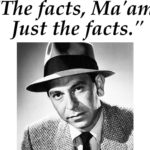Do you agree only with facts that support your viewpoint? Do you make a decision about something and then go back and find evidence to support your decision and ignore facts that don’t support your decision? If so, you may be a victim of Confirmation Bias.
Investing Problem
Confirmation bias is one of a number of logic mistakes people are guilty of when making investment decisions. It is very difficult not to favor information or facts that back up your choices. Confirmation bias in investing starts with a pre-conceived opinion about a stock. The investor develops an opinion prior to looking at any of the data. Let’s use Apple as an example. You (as an investor) walk past an Apple store in the mall and see that it is packed with customers, and you interpolate from this that Apple’s future prospects are good. You then go online to look up analyst reports and find that 28 of the 29 analysts that cover Apple have either a Strong Buy or Hold rating on the stock. You conclude this is positive news that supports your positive outlook, and so you go ahead and buy the stock. You may think you have done your own research by going to the Apple store and seeing the big crowd, but the analysts’ thoughts are not yours – they are the analysts’. Just because they all on balance think Apple’s prospects are good doesn’t mean that Apple stock will go up. For instance, the crowded store you saw: Is it more or less crowded than it was 3, 6 or 12 months ago? Or will it be more or less crowded 3 months from now? The store evidence you saw was purely random and anecdotal. The analyst reports you read fed your preconceived notion or bias that Apple’s prospects were good and that you would buy Apple stock. Apple might go up, but your thought process was flawed in making the buy decision.
Herbalife
A good example of how Confirmation Bias played out in real life was Bill Ackman and Pershing Square’s shorting of Herbalife stock. Ackman developed an opinion that Herbalife was a pyramid scheme and developed an argument based only on “evidence” that supported his position. Ackman then went about taking a short position in Herbalife stock and then taking to the airwaves to badmouth Herbalife and thereby drive down the stock and increase the profitability of his short position. The problem was that there was an equal amount of evidence that Herbalife’s multi-level marketing structure was legitimate and that the company’s sales were in fact growing and properly reported. Ackman’s Confirmation Bias about Herbalife cost him dearly – as I wrote in “Short Selling” on March 13, 2018, Ackman lost at least $1 Billion on the failed Herbalife short and he has had to cut 25% of his staff as he covered the trade.
The Correct Mindset
Instead of developing an opinion and then going out and finding data that proves your opinion, you need to do it the other way around. You need to approach it like Officer Joe Friday on Dragnet: “Just the facts, Ma’am.” Analyze all of the facts and then make a call based your analysis. Don’t jump to conclusions – one of my father’s favorite sayings. The crowded Apple store is good news, but you have to understand the context of that crowd, and determine what drives the crowd and whether it is likely to get more or less crowded in the future.

IMO
Confirmation Bias makes you feel more comfortable. The proper method of analysis can make you uncomfortable. Confirmation Bias is based on emotion and preconceived notions, but proper analysis is based on proper logic. Don’t ignore data that doesn’t support your theory – at least address that data and determine whether or not it is valid. Be more like Joe Friday, or like Missouri, the Show-Me State. It is your money and you should not make logical mistakes with what you do with it. Another way to minimize Confirmation Bias: Stay diversified among asset classes, and look at mutual funds or ETF’s if you don’t have a lot of money to invest.
